Spatial Correlation of Non-Agriculturalization and Non-Grain Utilization Transformation of Cultivated Land in China and Its Implications
Abstract
1. Introduction
2. Theoretical Explanation of Cultivated Land Transformation
2.1. Theoretical Explanation of NA and NGU Transformation
2.1.1. Theoretical Explanation of NA Transformation
2.1.2. Theoretical Explanation of NGU Transformation
2.2. Explanation of Spatial Correlation Between NA and NGU Transformation
3. Materials and Methods
3.1. Study Area
3.2. Data Source and Preprocessing
3.2.1. Data Sources
3.2.2. Identification of NA and NGU of Cultivated Land in the Study Area
3.3. Methodologies
3.3.1. Geographical Convergent Cross Mapping for Identify Causal Correlations
3.3.2. A Spatial Matching Degree Model for Measuring Correlations
3.3.3. Spatial Econometric Model
3.3.4. Multinomial Logistic Regression Model
4. Results
4.1. Spatial Pattern of NA and NGU Transformation in the Study Area
4.2. Factors Influencing NA and NGU Transformation in the Study Area
4.3. Correlation Between NA and NGU of Cultivated Land in the Study Area
5. Discussion
5.1. Mechanism of Correlation Between NA and NGU Transformation of Cultivated Land
5.2. Spatial Correlation Between NA and NGU of Cultivated Land in Other Cities of China
5.3. Policy Implications for Cultivated Land Protection and Management
6. Conclusions
Supplementary Materials
Author Contributions
Funding
Data Availability Statement
Conflicts of Interest
References
- Qiu, B.; Hu, X.; Chen, C.; Tang, Z.; Yang, P.; Zhu, X.; Yan, C.; Jian, Z. Maps of cropping patterns in China during 2015–2021. Sci. Data 2022, 9, 479. [Google Scholar] [CrossRef] [PubMed]
- Zhang, W.; Qie, R. Spatiotemporal change of cultivated land in China during 2000–2020. PLoS ONE 2024, 19, e0293082. [Google Scholar] [CrossRef] [PubMed]
- Zhao, S.; Yin, M. Change of urban and rural construction land and driving factors of arable land occupation. PLoS ONE 2023, 18, e0286248. [Google Scholar] [CrossRef] [PubMed]
- Lan, Y.; Xu, B.; Huan, Y.; Guo, J.; Liu, X.; Han, J.; Li, K. Food Security and Land Use under Sustainable Development Goals: Insights from Food Supply to Demand Side and Limited Arable Land in China. Foods 2023, 12, 4168. [Google Scholar] [CrossRef]
- Deng, X.; Huang, J.; Rozelle, S.; Zhang, J.; Li, Z. Impact of urbanization on cultivated land changes in China. Land Use Policy 2015, 45, 1–7. [Google Scholar] [CrossRef]
- Gong, B. Agricultural reforms and production in China: Changes in provincial production function and productivity in 1978–2015. J. Dev. Econ. 2018, 132, 18–31. [Google Scholar] [CrossRef]
- He, C.; Liu, Z.; Xu, M.; Ma, Q.; Dou, Y. Urban expansion brought stress to food security in China: Evidence from decreased cropland net primary productivity. Sci. Total Environ. 2017, 576, 660–670. [Google Scholar] [CrossRef]
- Wijesingha, J.; Astor, T.; Nautiyal, S.; Wachendorf, M. Spatial Patterns and Characteristics of Urban—Rural Agricultural Landscapes: A Case Study of Bengaluru, India. Land 2025, 14, 208. [Google Scholar] [CrossRef]
- Pravalie, R.; Patriche, C.; Borrelli, P.; Panagos, P.; Rosca, B.; Dumitrascu, M.; Nita, I.; Savulescu, I.; Birsan, M.; Bandoc, G. Arable lands under the pressure of multiple land degradation processes. A global perspective. Environ. Res. 2021, 194, 110697. [Google Scholar] [CrossRef]
- Qu, F.; Chen, J.; Chen, W. Theoretical and Empirical Study on the Land Conversion Economic Driving Forces. J. Nat. Resour. 2005, 20, 231–241. [Google Scholar]
- Lin, L.; Ye, Z.; Gan, M.; Shahtahmassebi, A.; Weston, M.; Deng, J.; Lu, S.; Wang, K. Quality Perspective on the Dynamic Balance of Cultivated Land in Wenzhou, China. Sustainability 2017, 9, 95. [Google Scholar] [CrossRef]
- Liu, L.; Liu, Z.; Gong, J.; Wang, L.; Hu, Y. Quantifying the amount, heterogeneity, and pattern of farmland: Implications for China’s requisition-compensation balance of farmland policy. Land Use Policy 2019, 81, 256–266. [Google Scholar] [CrossRef]
- Liu, Y.; Shen, G.; He, T. Cropping and Transformation Features of Non-Grain Cropland in Mainland China and Policy Implications. Land 2025, 14, 561. [Google Scholar] [CrossRef]
- Su, H.; Liu, F.; Zhang, H.; Ma, X.; Sun, A. Progress and Prospects of Non-Grain Production of Cultivated Land in China. Sustainability 2024, 16, 3517. [Google Scholar] [CrossRef]
- Ge, D.; Long, H.; Zhang, Y.; Ma, L.; Li, T. Farmland transition and its influences on grain production in China. Land Use Policy 2018, 70, 94–105. [Google Scholar] [CrossRef]
- Kong, X. The Issue of “Non-Grain Conversion” of Arable Land, Its Causes, and Countermeasures. China Land 2020, 11, 17–19. [Google Scholar]
- Yang, Q.; Zhang, D. The influence of agricultural industrial policy on non-grain production of cultivated land: A case study of the “one village, one product” strategy implemented in Guanzhong Plain of China. Land Use Policy 2021, 108, 105579. [Google Scholar] [CrossRef]
- Li, M.; Tan, L.; Yang, X. The Impact of Environmental Regulation on Cultivated Land Use Eco-Efficiency: Evidence from China. Agriculture 2023, 13, 1723. [Google Scholar] [CrossRef]
- Liang, K.; Jin, X.; Wang, S.; Ying, S.; Qi, Z.; Zhou, Y. Control of Balancing Cultivated Land Conversion by Integrating” Homogeneous Equivalence” and “Loss-Supplement Balance”: Methodology and Empirical Study. China Land Sci. 2023, 37, 77–88. [Google Scholar]
- Li, R.; Wang, R.; Li, M. Study on Non-agricultural Scale and Spatial-temporal Collocation of Cultivated Land in Henan Province. Hunan Agric. Sci. 2009, 65–68+72. [Google Scholar] [CrossRef]
- Guan, X.; Wang, X.; Zhao, Y. Morphological Characteristics Identification and Optimization of “Non-grain” Cultivated Land along Yellow River Basin. Trans. Chin. Soc. Agric. Mach. 2021, 52, 233–242. [Google Scholar]
- Tan, Y.; Wu, C.; Mou, Y. Macro-Analysis of Cultivated Land Non-Agriculturalization in Zhejiang. Sci. Geogr. Sin. 2004, 24, 14–19. [Google Scholar]
- Su, Y.; Li, C.; Wang, K.; Deng, J.; Shahtahmassebi, A.R.; Zhang, L.; Ao, W.; Guan, T.; Pan, Y.; Gan, M. Quantifying the spatiotemporal dynamics and multi-aspect performance of non-grain production during 2000–2015 at a fine scale. Ecol. Indic. 2019, 101, 410–419. [Google Scholar] [CrossRef]
- Cheng, M.; Liu, Y. Spatial Differentiation and Its Influencing Factors of Non-agricultural Land in Huang Huai-Hai Plain. Areal Res. Dev. 2019, 38, 170–176. [Google Scholar]
- Zhang, H.; Song, W.; Zhang, W.; Li, X.; Liu, J.; Li, J. Analysis of Spatial Differentiation Characteristics and Influencing Factors of Non-grain Cultivated Land in Shandong Province. China Land Sci. 2021, 35, 94–103. [Google Scholar]
- Ke, S.; Cui, H.; Lu, X.; Hou, J.; Wu, Y. Research on the Spatial-Temporal Pattern and Mechanisms of Green Transition of Farmland Use: A Case of Hubei Province. China Land Sci. 2021, 35, 64–74. [Google Scholar]
- Ma, C.; Zhao, L.; Ke, X. Temporal and Spatial Variation of the Pressure of Cropland Non-Agriculturalization in Hubei Province. Resour. Environ. Yangtze Basin 2016, 25, 71–78. [Google Scholar]
- Zhang, J.; Liu, Y.; Zhang, E.; Chen, J.; Tan, Q. Dynamics and driving mechanisms of cultivated land at county level in China. Acta Geogr. Sin. 2023, 78, 2105–2127. [Google Scholar]
- Zhang, D.; Yang, W.; Kang, D.; Zhang, H. Spatial-temporal characteristics and policy implication for non-grain production of cultivated land in Guanzhong Region. Land Use Policy 2023, 125, 106466. [Google Scholar] [CrossRef]
- Lu, D.; Wang, Z.; Su, K.; Zhou, Y.; Li, X.; Lin, A. Understanding the impact of cultivated land-use changes on China’s grain production potential and policy implications: A perspective of non-agriculturalization, non-grainization, and marginalization. J. Clean. Prod. 2024, 436, 140647. [Google Scholar] [CrossRef]
- Qiu, T.; Boris Choy, S.T.; Li, S.; He, Q.; Luo, B. Does land renting-in reduce grain production? Evidence from rural China. Land Use Policy 2020, 90, 104311. [Google Scholar] [CrossRef]
- Ma, Z.; Ran, R.; Xu, D. The Effect of Peasants Differentiation on Peasants’ Willingness and Behavior Transformation of Land Transfer: Evidence from Sichuan Province, China. Land 2023, 12, 338. [Google Scholar] [CrossRef]
- Mustafa, A.; Heppenstall, A.; Omrani, H.; Saadi, I.; Cools, M.; Teller, J. Modelling built-up expansion and densification with multinomial logistic regression, cellular automata and genetic algorithm. Comput. Environ. Urban Syst. 2018, 67, 147–156. [Google Scholar] [CrossRef]
- Zhu, Z.; Duan, J.; Li, S.; Dai, Z.; Feng, Y. Phenomenon of Non-Grain Production of Cultivated Land Has Become Increasingly Prominent over the Last 20 Years: Evidence from Guanzhong Plain, China. Agriculture 2022, 12, 1654. [Google Scholar] [CrossRef]
- Wang, X.; Song, X.; Wang, Y.; Xu, H.; Ma, Z. Understanding the distribution patterns and underlying mechanisms of non-grain use of cultivated land in rural China. J. Rural. Stud. 2024, 106, 103223. [Google Scholar] [CrossRef]
- Gao, B.; Yang, J.; Chen, Z.; Sugihara, G.; Li, M.; Stein, A.; Kwan, M.; Wang, J. Causal inference from cross-sectional earth system data with geographical convergent cross mapping. Nat. Commun. 2023, 14, 5875. [Google Scholar] [CrossRef] [PubMed]
- Ma, Y.; Wang, X.; Zhong, C. Spatial and Temporal Differences and Influencing Factors of Eco-Efficiency of Cultivated Land Use in Main Grain-Producing Areas of China. Sustainability 2024, 16, 5734. [Google Scholar] [CrossRef]
- Lai, Z.; Chen, M.; Liu, T. Changes in and prospects for cultivated land use since the reform and opening up in China. Land Use Policy 2020, 97, 104781. [Google Scholar] [CrossRef]
- Zhang, Z.; Ghazali, S.; Miceikiene, A.; Zejak, D.; Choobchian, S.; Pietrzykowski, M.; Azadi, H. Socio-economic impacts of agricultural land conversion: A meta-analysis. Land Use Policy 2023, 132, 106831. [Google Scholar] [CrossRef]
- Su, Y.; Wang, X.; Wang, C.; Zhu, C.; Jiang, Q.; Li, Y. Trade-offs between economic benefits and environmental impacts in non-grain expansion: A case study in the eastern plain of China. Environ. Sci. Pollut. Res. 2024, 31, 15932–15945. [Google Scholar] [CrossRef]
- Wang, Y.; Zhang, Y.; Yang, H.; Niu, J.; Chen, X. Effects of Payments for Ecosystem Services and Livelihoods on Non-Grain Agricultural Land Use. Forests 2024, 15, 521. [Google Scholar] [CrossRef]
- Han, H.; Peng, H.; Li, S.; Yang, J.; Yan, Z. The Non-Agriculturalization of Cultivated Land in Karst Mountainous Areas in China. Land 2022, 11, 1727. [Google Scholar] [CrossRef]
- Ran, D.; Zhang, Z.; Jing, Y. A Study on the Spatial–Temporal Evolution and Driving Factors of Non-Grain Production in China’s Major Grain-Producing Provinces. Int. J. Environ. Res. Public Health 2022, 19, 16630. [Google Scholar] [CrossRef] [PubMed]
- Liu, J.; Dong, C.; Liu, S.; Rahman, S.; Sriboonchitta, S. Sources of Total-Factor Productivity and Efficiency Changes in China’s Agriculture. Agriculture 2020, 10, 279. [Google Scholar] [CrossRef]
- Pan, S.; Di, C.; Qu, Z.; Ali Chandio, A.; Rehman, A.; Zhang, H. How do agricultural subsidies affect farmers’ non-grain cultivated land production? Evidence from the fourth rural Chinese households panel data survey. Econ. Polit. 2024, 41, 1–24. [Google Scholar] [CrossRef]
- Su, Y.; Qian, K.; Lin, L.; Wang, K.; Guan, T.; Gan, M. Identifying the driving forces of non-grain production expansion in rural China and its implications for policies on cultivated land protection. Land Use Policy 2020, 92, 104435. [Google Scholar] [CrossRef]
- Zhang, Z.; Zheng, L.; Yu, D. Non-Grain Production of Cultivated Land in Hilly and Mountainous Areas at the Village Scale: A Case Study in Le’an Country, China. Land 2023, 12, 1562. [Google Scholar] [CrossRef]
- Lyu, X.; Peng, W.; Niu, S.; Qu, Y.; Xin, Z. Evaluation of sustainable intensification of cultivated land use according to farming households’ livelihood types. Ecol. Indic. 2022, 138, 108848. [Google Scholar] [CrossRef]
- Chen, L.; Peng, J.; Zhang, Y. Research on the Impact of Rural Land Transfer on Non-Farm Employment of Farm Households: Evidence from Hubei Province, China. Int. J. Environ. Res. Public Health 2022, 19, 15587. [Google Scholar] [CrossRef]
- Wang, X.; Wang, D.; Wu, S.; Yan, Z.; Han, J. Cultivated land multifunctionality in undeveloped peri-urban agriculture areas in China: Implications for sustainable land management. J. Environ. Manag. 2023, 325, 116500. [Google Scholar] [CrossRef]
- Zhu, F.; Zhang, F.; Ke, X. Rural industrial restructuring in China’s metropolitan suburbs: Evidence from the land use transition of rural enterprises in suburban Beijing. Land Use Policy 2018, 74, 121–129. [Google Scholar] [CrossRef]
- Cheng, X.; Tao, Y.; Huang, C.; Yi, J.; Yi, D.; Wang, F.; Tao, Q.; Xi, H.; Ou, W. Unraveling the Causal Mechanisms for Non-Grain Production of Cultivated Land: An Analysis Framework Applied in Liyang, China. Land 2022, 11, 1888. [Google Scholar] [CrossRef]
- Shan, L.; Jiang, Y.; Liu, C.; Wang, Y.; Zhang, G.; Cui, X.; Li, F. Exploring the multi-dimensional coordination relationship between population urbanization and land urbanization based on the MDCE model: A case study of the Yangtze River Economic Belt, China. PLoS ONE 2021, 16, e0253898. [Google Scholar] [CrossRef]
- Bivand, R.; Piras, G. Comparing Implementations of Estimation Methods for Spatial Econometrics. J. Stat. Softw. 2015, 63, 1–36. [Google Scholar] [CrossRef]
- Wu, X.; Zhao, N.; Wang, Y.; Zhang, L.; Wang, W.; Liu, Y. Cropland non-agriculturalization caused by the expansion of built-up areas in China during 1990–2020. Land Use Policy 2024, 146, 107312. [Google Scholar] [CrossRef]
- Tan, R.; Liu, Y.; Zhou, K.; Jiao, L.; Tang, W. A game-theory based agent-cellular model for use in urban growth simulation: A case study of the rapidly urbanizing Wuhan area of central China. Comput. Environ. Urban Syst. 2015, 49, 15–29. [Google Scholar] [CrossRef]
- Wei, J.; Tian, M.; Wang, X. Spatiotemporal Variation in Land Use and Ecosystem Services during the Urbanization of Xining City. Land 2023, 12, 1118. [Google Scholar] [CrossRef]
- Jiang, Z.; Luo, Y.; Wen, Q.; Shi, M.; Ayyamperumal, R.; Wang, M. Achieving Sustainable Land Use Allocation in High-Altitude Area by 2030: Insights from Circle Structure and Scenario Predictions for Production–Living–Ecological Land in Xining Marginal Area, China. Land 2024, 13, 1241. [Google Scholar] [CrossRef]
- Zhai, H.; Lv, C.; Liu, W.; Yang, C.; Fan, D.; Wang, Z.; Guan, Q. Understanding Spatio-Temporal Patterns of Land Use/Land Cover Change under Urbanization in Wuhan, China, 2000–2019. Remote Sens. 2021, 13, 3331. [Google Scholar] [CrossRef]
- Bren D Amour, C.; Reitsma, F.; Baiocchi, G.; Barthel, S.; Güneralp, B.; Erb, K.; Haberl, H.; Creutzig, F.; Seto, K.C. Future urban land expansion and implications for global croplands. Proc. Natl. Acad. Sci. USA 2017, 114, 8939–8944. [Google Scholar] [CrossRef]
- van Vliet, J. Direct and indirect loss of natural area from urban expansion. Nat. Sustain. 2019, 2, 755–763. [Google Scholar] [CrossRef]
- Ustaoglu, E.; Collier, M.J. Farmland abandonment in Europe: An overview of drivers, consequences, and assessment of the sustainability implications. Environ. Rev. 2018, 26, 396–416. [Google Scholar] [CrossRef]
- Wang, L.; Zheng, W.; Tang, L.; Zhang, S.; Liu, Y.; Ke, X. Spatial optimization of urban land and cropland based on land production capacity to balance cropland protection and ecological conservation. J. Environ. Manag. 2021, 285, 112054. [Google Scholar] [CrossRef]
- Jiang, G.; Zhang, R.; Ma, W.; Zhou, D.; Wang, X.; He, X. Cultivated land productivity potential improvement in land consolidation schemes in Shenyang, China: Assessment and policy implications. Land Use Policy 2017, 68, 80–88. [Google Scholar] [CrossRef]
- Yang, Y.; Zhang, L.; Ye, Y.; Wang, Z. Curbing Sprawl with Development-limiting Boundaries in Urban China: A Review of Literature. J. Plan. Lit. 2020, 35, 25–40. [Google Scholar] [CrossRef]
- Chen, Y.; Li, M.; Zhang, Z. Does the Rural Land Transfer Promote the Non-Grain Production of Cultivated Land in China? Land 2023, 12, 688. [Google Scholar] [CrossRef]
- Guo, Y.; Wang, J. Land Consolidation in Rural China: Historical Stages, Typical Modes, and Improvement Paths. Land 2023, 12, 491. [Google Scholar] [CrossRef]
- Zhou, Y.; Li, Y.; Xu, C. Land consolidation and rural revitalization in China: Mechanisms and paths. Land Use Policy 2020, 91, 104379. [Google Scholar] [CrossRef]
- Wang, W.; Gu, Z.; Han, Z.; Li, Z. Optimization of land use to accommodate nutritional transformation of food systems: A case study from the Beijing–Tianjin–Hebei region. Front. Sustain. Food Syst. 2024, 8, 1326581. [Google Scholar] [CrossRef]
- Zhang, T.; Zhang, F.; Li, J.; Xie, Z.; Chang, Y. Unraveling patterns, causes, and nature-based remediation strategy for non-grain production on farmland in hilly regions. Environ. Res. 2024, 252, 118982. [Google Scholar] [CrossRef]
- Zhao, Y.; Abdelkareem, M.; Abdalla, F. Remote sensing and GIS techniques in Monitoring and mapping Land System Change in semi-arid environments. Environ. Earth Sci. 2024, 83, 420. [Google Scholar] [CrossRef]
- Spataru, A.; Faggian, R.; Docking, A. Principles of multifunctional agriculture for supporting agriculture in metropolitan peri-urban areas: The case of Greater Melbourne, Australia. J. Rural. Stud. 2020, 74, 34–44. [Google Scholar] [CrossRef]
- Fregolent, L.; Vettoretto, L. Land use regulation and social regulation: An unexplored link. Some reflections on the origins and evolution of sprawl in the Veneto “citta diffusa”. Land Use Policy 2017, 69, 149–159. [Google Scholar] [CrossRef]
- Osman, T. Restrictive Land Use Regulations and Economic Performance. Int. Reg. Sci. Rev. 2020, 43, 291–315. [Google Scholar] [CrossRef]
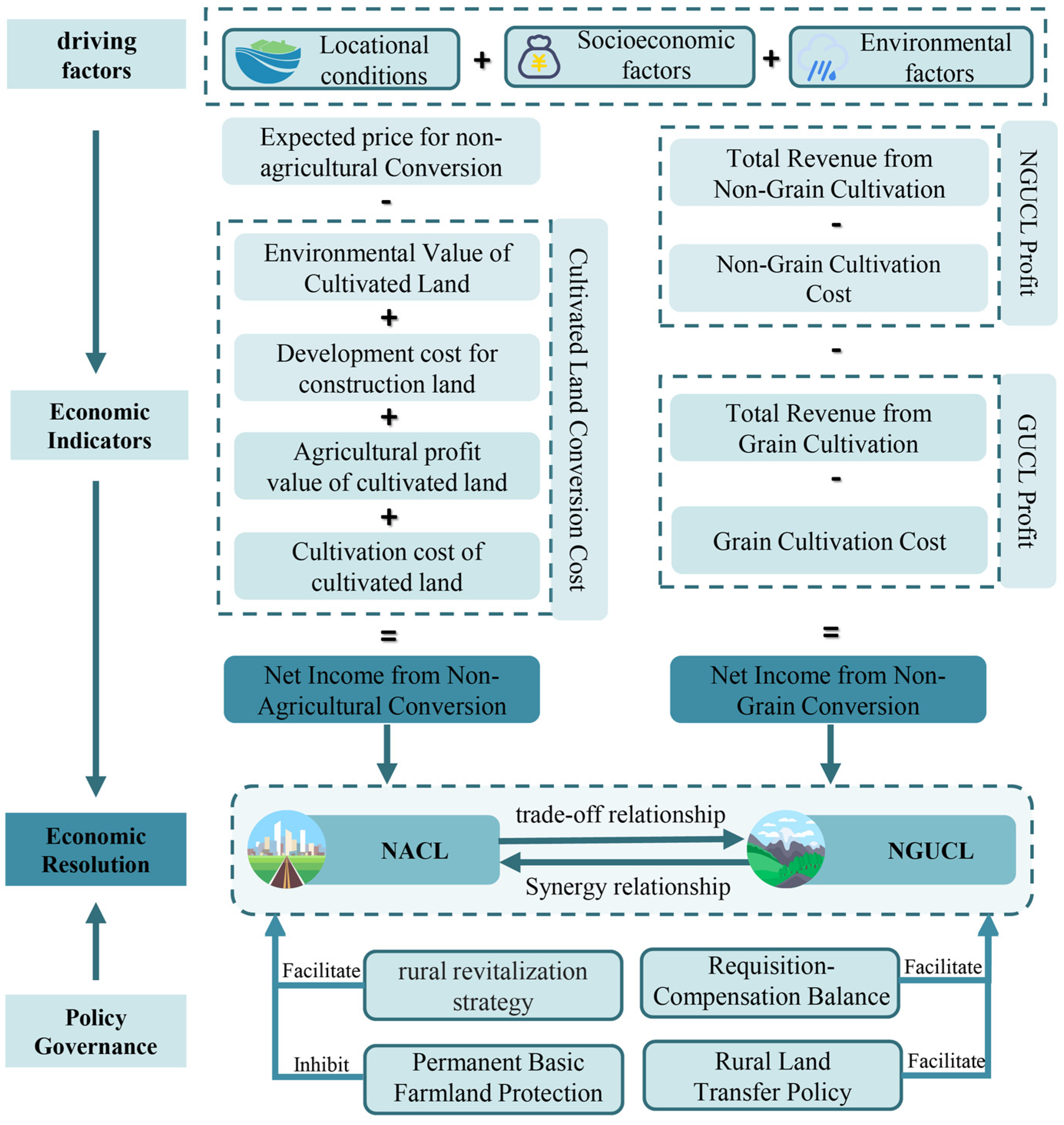
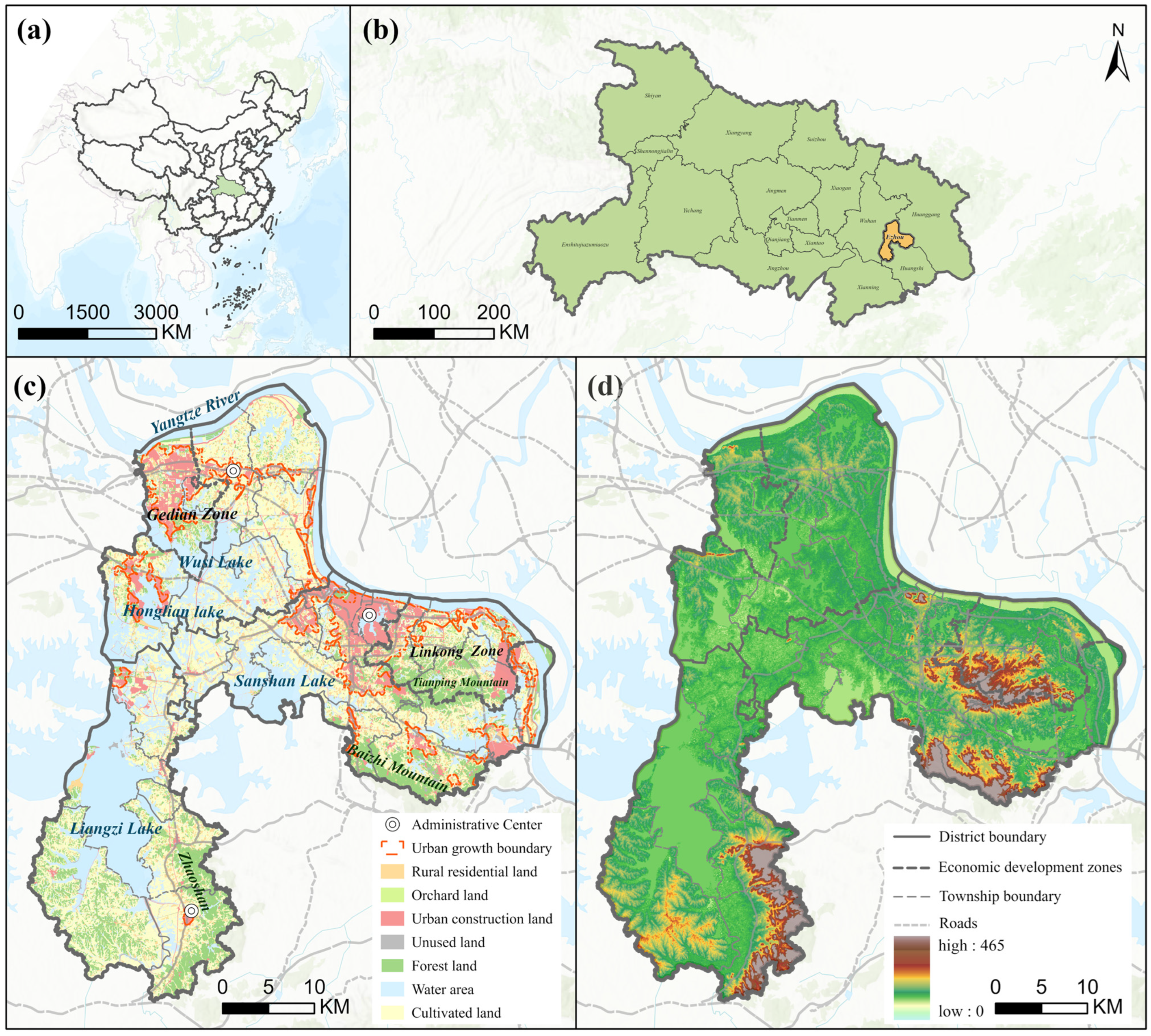
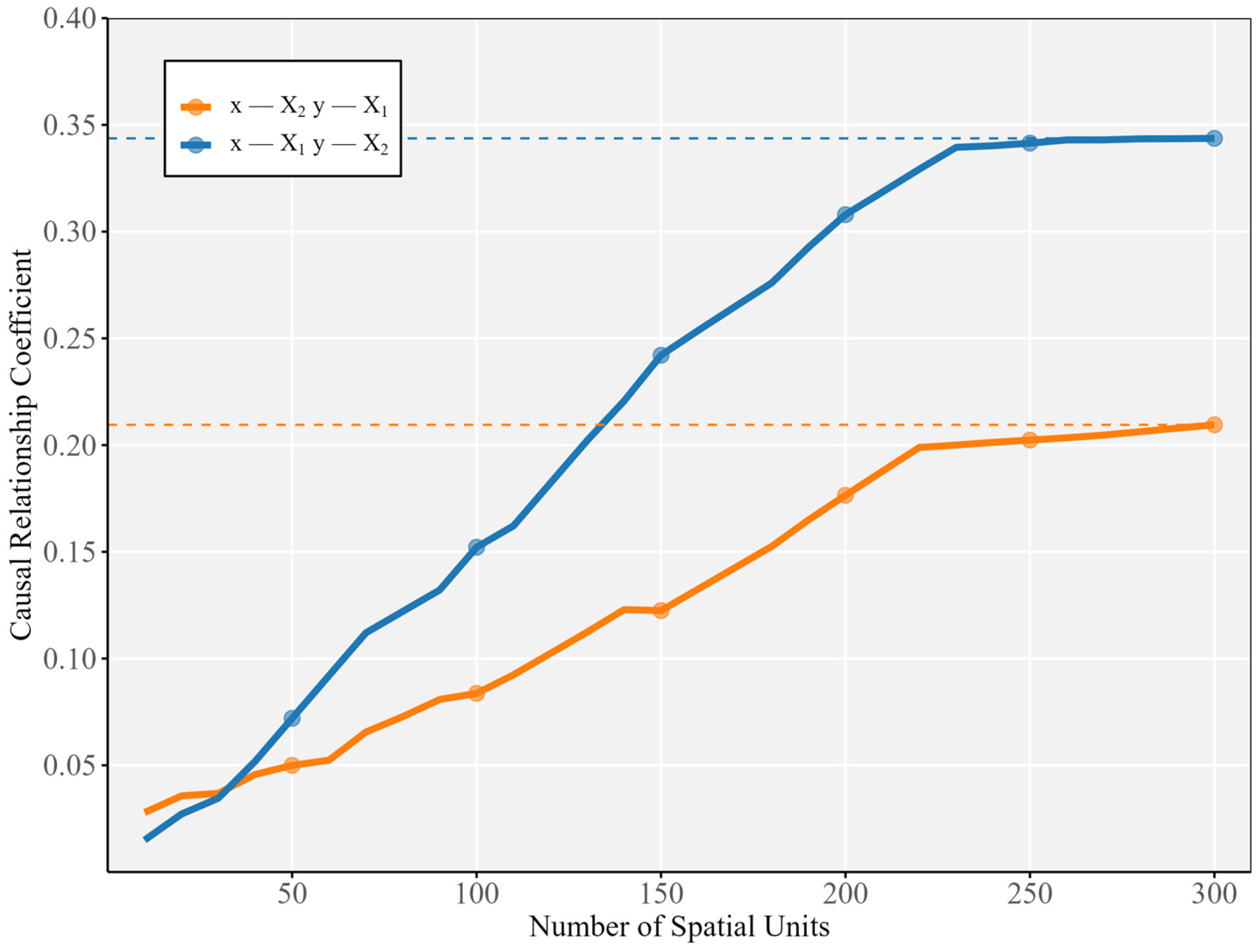

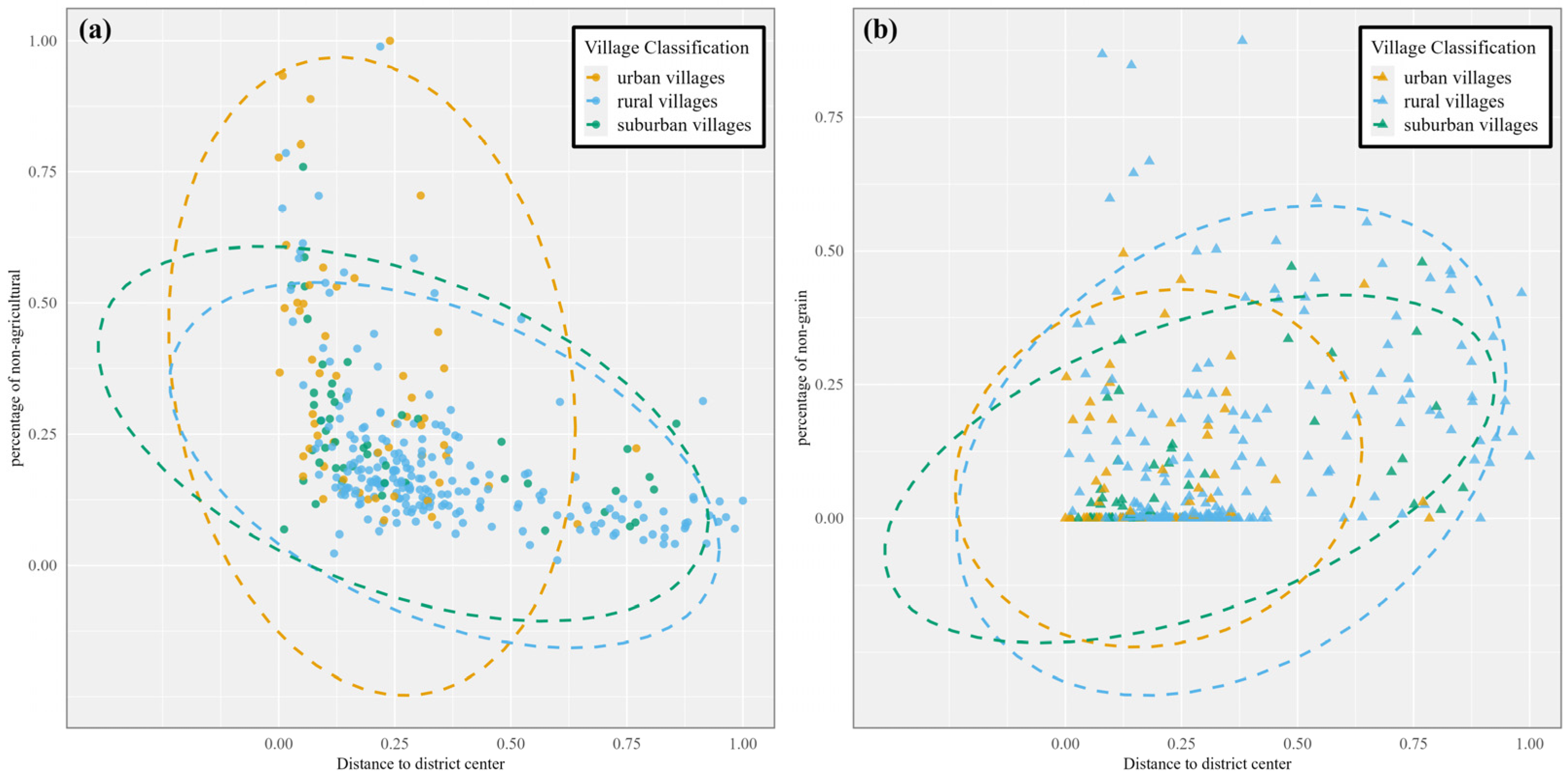

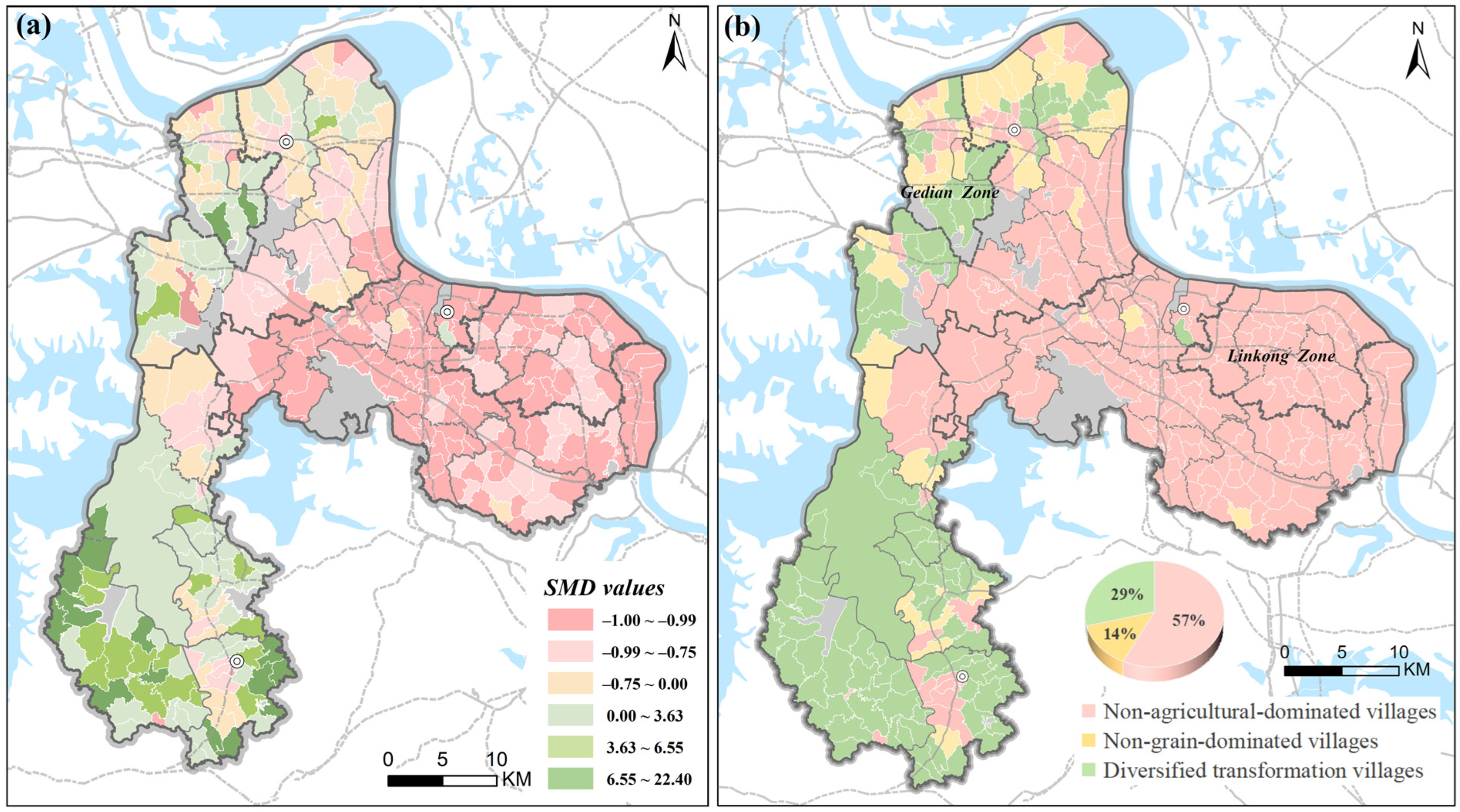
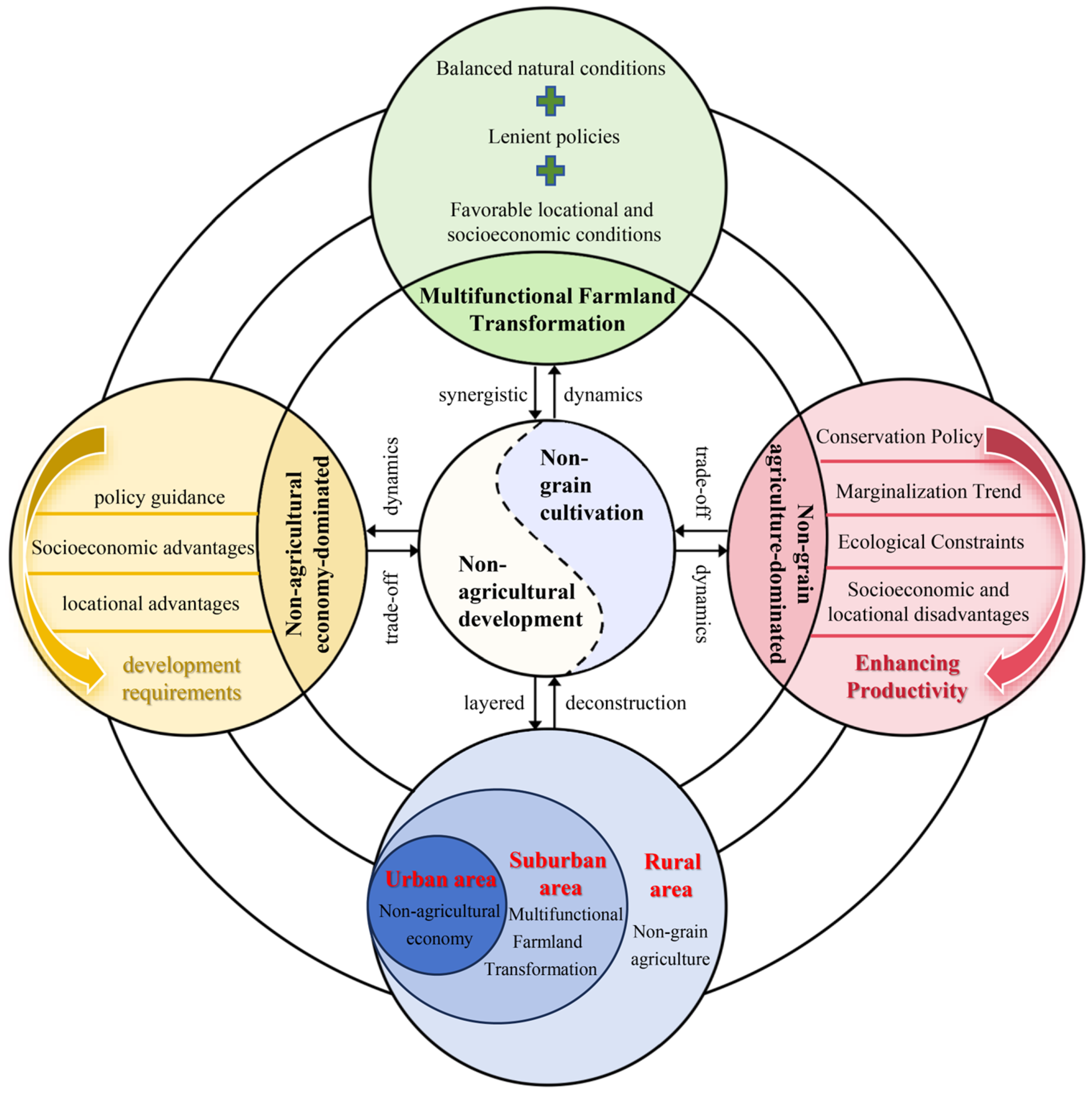
| Range of SMD | Correlation Pattern | Explanation of Correlation Pattern | Type of Village |
|---|---|---|---|
| SMD ≥ 0.5 | Trade-off | The NGU rate is significantly higher than the NA rate, and NGU excludes NA | Non-grain-dominated |
| 0 ≤ SMD < 0.5 | Synergy | Both NGU and NA are high, with the NGU rate higher than the NA rate | Diversified farmland transformation |
| −0.5 < SMD < 0 | Synergy | Both NGU and NA are high, with the NA rate higher than the NGU rate | Diversified farmland transformation |
| SMD ≤ −0.5 | Trade-off | The NA rate is significantly higher than the NGU rate, and NA excludes NGU | Non-agricultural-dominated |
| Factors | Variables | Calculation Method | Explanation |
|---|---|---|---|
| Location | Distance to district center | Distance from the center of a village to the nearest district-level urban center | Reflects the degree of connection with the district center, related to land value |
| Convenience of grain production | Proportion of the total area of rural settlement within the 100 m buffer zones of cultivated land | Reflects the convenience of agricultural production | |
| Socioeconomic | Nighttime light intensity | Average intensity of nighttime light in a village | Reflects the economic development and population density of each village, related to land value |
| Density of construction land | Area of construction land/total area of a village | Reflects the economic development status of each village, related to land value | |
| Density of road | Total area of road/total area of a village | Reflects the level of transportation convenience and economic development | |
| Natural Conditions | Slope | Average slope of cultivated land within a village | Reflects the overall steepness of the terrain and cultivation conditions, related to agricultural production efficiency |
| Elevation | Average elevation of cultivated land within a village | Reflects the terrain conditions of the cultivated land, related to agricultural production costs | |
| Accessibility to water | Proportion of the total area of water body within 100 m buffer zones of cultivated land | Reflects the convenience of irrigation and waterfront landscape value, related to land value and agricultural efficiency | |
| Proportion of cultivated land | Proportion of cultivated land area to total area of village | Reflects the abundance of cultivated land resources, related to agricultural output | |
| Quality of cultivated land | Quality of cultivated land is classified into 15 grades based on soil fertility, soil health, agriculture infrastructure conditions, and natural factors like terrain and climate | Reflects the comprehensive grain production capacity of the cultivated land | |
| Policy | Area of permanent basic farmland | Total area of permanent farmland in a village | Reflects the endowment and level of protection of cultivated land resources |
| Variables | Standardized Regression Coefficient | Standard Error | p-Value |
|---|---|---|---|
| Distance to district center | −0.32 | 0.049 | 0.000 |
| Convenience of grain production | −0.168 | 0.059 | 0.004 |
| Nighttime light intensity | 0.608 | 0.045 | 0.000 |
| Density of construction land | 0.666 | 0.030 | 0.000 |
| Density of road | 0.105 | 0.071 | 0.135 |
| Elevation | −0.165 | 0.071 | 0.020 |
| Accessibility to water | 0.070 | 0.074 | 0.339 |
| Proportion of cultivated land | −0.369 | 0.036 | 0.000 |
| Quality of cultivated land | −0.177 | 0.048 | 0.000 |
| Area of permanent basic farmland | −0.420 | 0.062 | 0.000 |
| Variables | Standardized Regression Coefficient | Standard Error | p-Value |
|---|---|---|---|
| Distance to district center | 0.088 | 0.037 | 0.017 |
| Convenience of grain production | −0.091 | 0.05 | 0.069 |
| Nighttime light intensity | −0.078 | 0.046 | 0.094 |
| Density of construction land | −0.106 | 0.04 | 0.008 |
| Density of road | 0.024 | 0.064 | 0.707 |
| Elevation | 0.063 | 0.059 | 0.283 |
| Accessibility to water | −0.127 | 0.059 | 0.031 |
| Proportion of cultivated land | −0.094 | 0.035 | 0.007 |
| Quality of cultivated land | 0.12 | 0.043 | 0.005 |
| Area of permanent basic farmland | 0.06 | 0.054 | 0.264 |
| Variables | Non-Agricultural-Dominated Village | Non-Grain-Dominated Village | Diversified Farmland Transformation Village | |||
|---|---|---|---|---|---|---|
| Coefficient | p-Value | Coefficient | p-Value | Coefficient | p-Value | |
| Distance to district center | −0.770 | 0.001 | 0.963 | 0.000 | −0.097 | 0.694 |
| Convenience of grain production | 0.320 | 0.049 | −0.348 | 0.029 | 0.070 | 0.649 |
| Nighttime light intensity | 0.206 | 0.255 | −0.293 | 0.117 | 0.130 | 0.482 |
| Density of construction land | 0.442 | 0.025 | −0.416 | 0.043 | 0.001 | 0.997 |
| Density of road | −0.160 | 0.213 | 0.183 | 0.157 | −0.044 | 0.726 |
| Slope | 0.082 | 0.570 | 0.048 | 0.715 | −0.101 | 0.497 |
| Elevation | 0.213 | 0.124 | −0.291 | 0.035 | 0.043 | 0.728 |
| Accessibility to water | −0.299 | 0.200 | 0.131 | 0.569 | 0.170 | 0.461 |
| Proportion of cultivated land | −0.392 | 0.044 | 0.272 | 0.135 | −0.025 | 0.898 |
| Quality of cultivated land | −0.224 | 0.125 | 0.267 | 0.067 | −0.027 | 0.860 |
Disclaimer/Publisher’s Note: The statements, opinions and data contained in all publications are solely those of the individual author(s) and contributor(s) and not of MDPI and/or the editor(s). MDPI and/or the editor(s) disclaim responsibility for any injury to people or property resulting from any ideas, methods, instructions or products referred to in the content. |
© 2025 by the authors. Licensee MDPI, Basel, Switzerland. This article is an open access article distributed under the terms and conditions of the Creative Commons Attribution (CC BY) license (https://creativecommons.org/licenses/by/4.0/).
Share and Cite
Wang, Y.; Song, D.; Liu, C.; Li, S.; Yuan, M.; Gong, J.; Yang, J. Spatial Correlation of Non-Agriculturalization and Non-Grain Utilization Transformation of Cultivated Land in China and Its Implications. Land 2025, 14, 1031. https://doi.org/10.3390/land14051031
Wang Y, Song D, Liu C, Li S, Yuan M, Gong J, Yang J. Spatial Correlation of Non-Agriculturalization and Non-Grain Utilization Transformation of Cultivated Land in China and Its Implications. Land. 2025; 14(5):1031. https://doi.org/10.3390/land14051031
Chicago/Turabian StyleWang, Yingge, Daiyi Song, Cheng Liu, Shuaicheng Li, Man Yuan, Jian Gong, and Jianxin Yang. 2025. "Spatial Correlation of Non-Agriculturalization and Non-Grain Utilization Transformation of Cultivated Land in China and Its Implications" Land 14, no. 5: 1031. https://doi.org/10.3390/land14051031
APA StyleWang, Y., Song, D., Liu, C., Li, S., Yuan, M., Gong, J., & Yang, J. (2025). Spatial Correlation of Non-Agriculturalization and Non-Grain Utilization Transformation of Cultivated Land in China and Its Implications. Land, 14(5), 1031. https://doi.org/10.3390/land14051031







